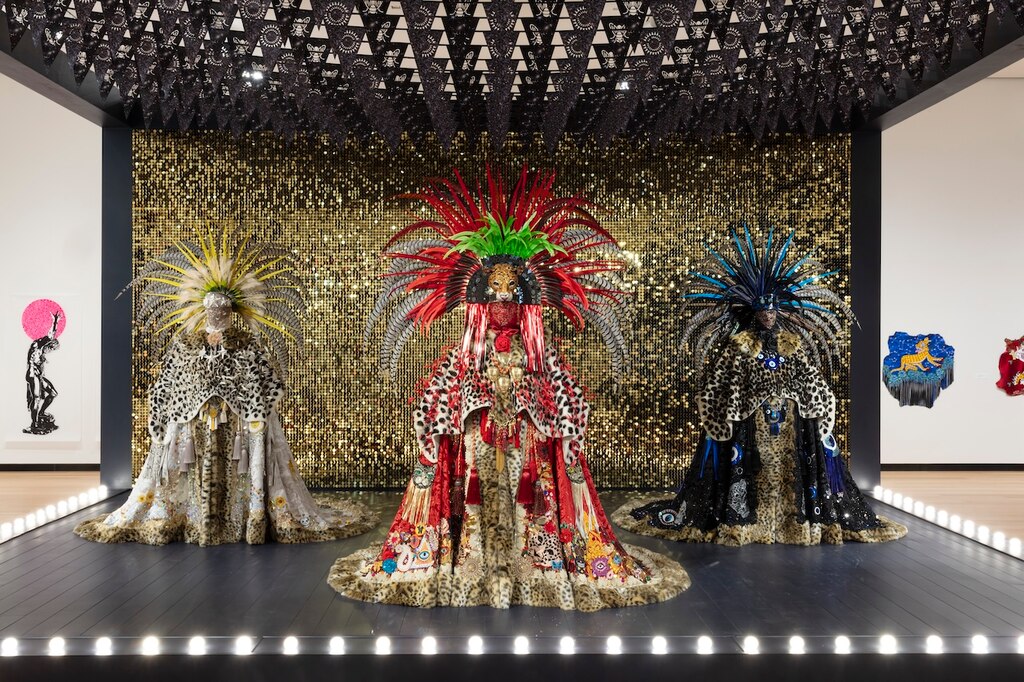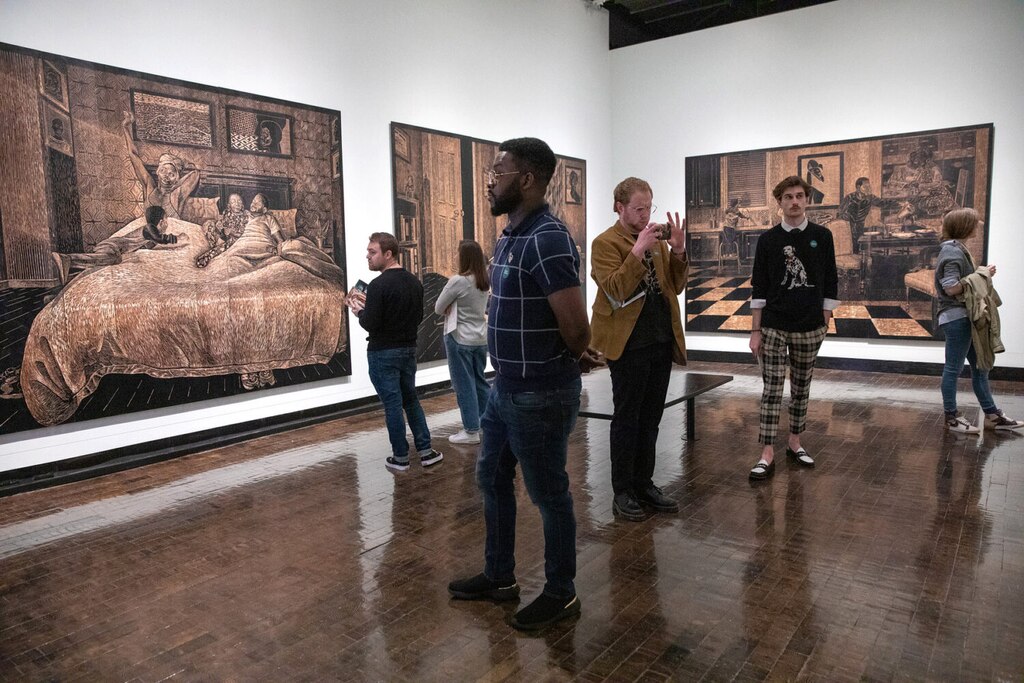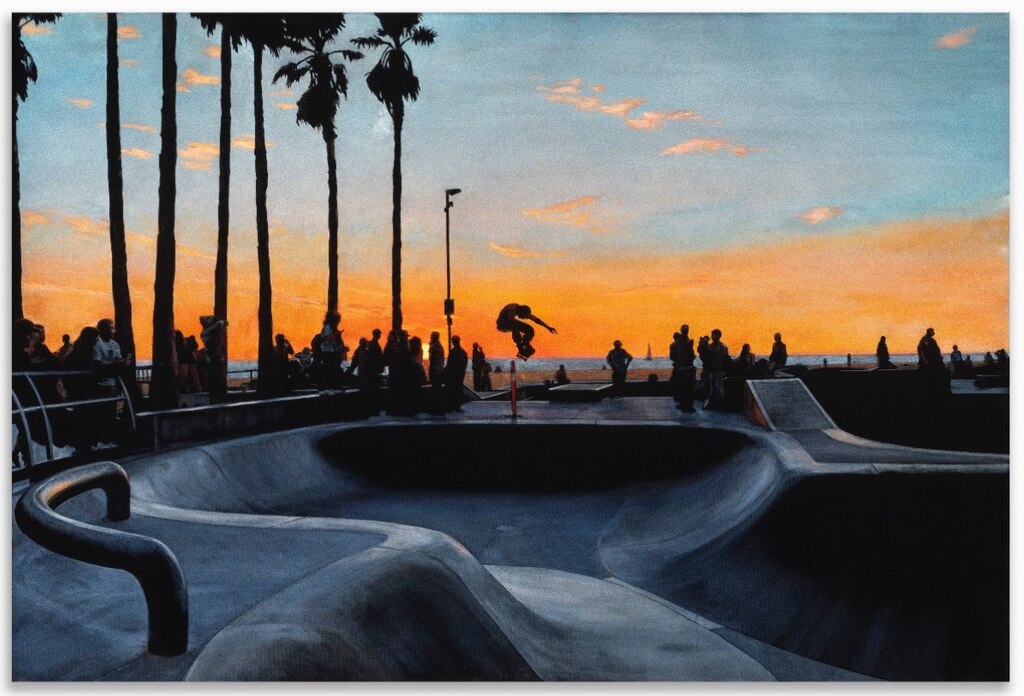This story is part of a partnership with The Baltimore Banner and BmoreArt that will provide monthly pieces focusing on the region’s artists, galleries and museums. For more stories like this, visit BmoreArt.com.
What does it say about our city’s pool of talent that the work of so many visual artists is being exhibited and collected across the country? Baltimore is an incredible city for creatives to live and make their work in, but artists on an upward trajectory often need to take their work elsewhere for ambitious professional opportunities. Rather than seeing this as a failure of vision or lack of resources within our local institutions, we can choose to consider a national exhibition career as the natural progression of artists on the rise and a clear sign of much greater things to come.
This March, I am putting seven Baltimore-based artists on your radar with nationally relevant solo exhibitions at galleries and museums across the country. Although they may not be easy to visit in person, you can still attend virtual lectures and events, follow them on Instagram and read about them in national publications. Since each artist’s studio and professional life is based in Baltimore, you can go to their website, sign up for their newsletter, set up a visit to their studio and plan to attend their next exhibit in town.
Rather than simply watching from the distant sidelines, we all have the opportunity to participate, saying “I told you so” with confidence, and “I knew them when.” Now is the time to create future bragging rights, especially if you are able to purchase a piece of their work at a Baltimore price point while you still can.
The Baltimore Banner thanks its sponsors. Become one.
Phaan Howng, ‘The Future of Orchids: Conservation and Collaboration’
The Kogod Courtyard at the Smithsonian American Art Museum and National Portrait Gallery
8th and G streets NW in Washington, D.C.
Through April 28

Is unbridled nature a source of beauty, or is it a threat to human life? What about nature that’s been disrupted by human activity? Phaan Howng’s environmentally focused paintings and sculpture walk a fine line between menacing and decorative, not unlike a Louise Bourgeois giant spider sculpture or a Tim Burton film. Perhaps you remember “Phaan Howng: The Succession of Nature,” the Maryland Institute College of Art graduate’s epic installation at the Baltimore Museum of Art from 2017 to 2018, which completely surrounded the viewer with interlocking, energetic neon vines. Hand-painted onto wallpaper, furniture and even the artist’s own clothing, Howng’s work educated audiences about impending environmental doom and the dark complexity of our relationship with nature, while working in partnership with Blue Water Baltimore, a nonprofit organization designed to improve water quality in the region.
Read More
This year, Howng has taken her climate change-minded work to an even higher level in “The Future of Orchids: Conservation and Collaboration,” hosted by the Smithsonian Gardens and the U.S. Botanic Garden. The installation fills the entire Kogod Courtyard of the Smithsonian American Art Museum and National Portrait Gallery with hot pink squiggles proliferating across 3D-scanned orchid sculptures and floating mountains. The large-scale, immersive and characteristic bright-colored items reference Howng’s ongoing bodies of work, but focus on one specific type of plant: the beloved but much misunderstood orchid. Not only are Howng’s works of art reaching an international, Smithsonian audience, they are peacefully co-existing with 350 live orchids from the Botanic Garden’s collection. This deliberate camouflage and immersion with the real thing, a merging of living and faux together inside a museum, takes Howng’s oeuvre to a logical next conclusion: Nature is a living and intelligent force to be reckoned with that evolves in reaction to human action, and the future is unpredictable.
The Baltimore Banner thanks its sponsors. Become one.
‘René Treviño: Stab of Guilt’
Ruth and Elmer Wellin Museum of Art at Hamilton College
198 College Hill Road in Clinton, New York
Through June 9

What does it mean to be queer and Mexican American in 2024? From the cosmos to the disco, from Montezuma to Liberace, ”René Treviño: Stab of Guilt,” on view through June 9 at the Wellin Museum of Art at Hamilton College in Clinton, New York, offers a gorgeous, vibrant take on queer human history that manages to be inclusive of everyone. It’s a wow from start to finish, with bold color, glitz and exquisite detail accumulated with such vivacity that the beauty almost belies an exhibit densely laden in historical, scientific and sociological research.
This is Treviño’s first museum survey, and the visual artist has been able to accumulate and incorporate all of the topics he has explored for over 20 years — astronomy, Maya and Aztec history, Catholic symbolism, pop culture and queer theory — in nearly 200 works created since 2008, including a new series of “star chart” collages created specifically for this institution. The show is realized at an optimal monumental scale that allows Treviño’s works to sing, but also for prolific bodies of work to be in close conversation with one another. He is rewriting his own heritage and identity in a new light where meticulous, time-intensive labor is elevated as a transcendent act that unites the artist with his ancestors.
The Baltimore Banner thanks its sponsors. Become one.
“Stab of Guilt” is curated by Alexander Jarman, assistant curator of exhibitions and academic outreach (formerly of The Walters Art Museum in Baltimore), who said, “The exhibition title connotes a unique blend of historical references, both personal to the artist and publicly known, including the violence often associated with the Aztec Empire, the private guilt engendered through religious doctrine, and the postcolonial reckonings faced by many cultural institutions, including art museums.” Viewing the accompanying Wellin-commissioned, nearly 18-minute-long documentary video, shot in Baltimore and Mexico City, is a must.
‘Kei Ito: Staring at the Face of the Sun’
Georgia Museum of Art at the University of Georgia
90 Carlton St. in Athens, Georgia
Through July 14

Kei Ito’s grandfather survived the atomic bomb dropped on Hiroshima and described it as “hundreds of suns lighting up the sky.” As a visual artist and first-generation Japanese American, Ito uses his photography as a way to explore “the intergenerational trauma of nuclear disaster and the possibilities of healing and reconciliation,” according to an event description on the University of Georgia website. His work adds a clear personal voice to the global conversation about nuclear war and nuclear testing, questioning what it means, individually and collectively, to be victim and/or aggressor in a nuclear conflict.
The Baltimore Banner thanks its sponsors. Become one.
Ito employs “camera-less” experimental photo techniques using light-sensitive paper and the sun for exposure. In his “Burning Away” series, the artist merges painting and photography through the chemigram process, invented by Belgian artist Pierre Cordier, in which liquid substances are slathered onto silver gelatin photo paper and exposed to the sun. The resulting images reference the universe as well as cellular structures, evoking the impact of radiation at a micro and macro scale. He incorporates survivors’ stories into material and compositional choices, such as his use of honey as one of the emulsion suspension media, since Hiroshima victims used it on their burns as a salve. The artist includes additional bodies of work in the show that address “downwinders,” the Americans who were exposed to nuclear testing sites between 1945 and 1992, as well as a performance piece and a series on the eyes of victims affected by nuclear activity.
Ito’s fiery images position the cataclysmic impact of nuclear war right in our faces, taking an almost incomprehensible subject and making it relatable by printing his images at a human scale. His “Staring at the Face of the Sun” exhibit is an invitation to consider lives lost, but also the resilience of the human spirit — even when faced with nuclear annihilation.
Murjoni Merriweather, ‘Singular Views: 25 Artists’
Rubell Museum
65 I St. SW in Washington, D.C.
Continues into October
The Baltimore Banner thanks its sponsors. Become one.

Murjoni Merriweather’s solo presentation of larger-than-life sculptural busts is in great company in Washington, D.C., at the Rubell Museum. The former Creative Alliance resident artist has exhibited her ceramic busts at Jeffrey Deitch in Los Angeles as well as the Walters in Baltimore, but seeing her familiar figures among legendary living artists like Amoako Boafo, Jenny Holzer, Hank Willis Thomas, Sylvia Snowden, Mickalene Thomas, John Waters and others at the Rubell Museum marks an exciting new chapter.
Merriweather, a MICA graduate, has been sculpting scaled-up clay busts for over a decade, transforming a historical art tradition employed by the ancient Greek, Egyptian, Ife and Benin civilizations to immortalize famous leaders in bronze and marble. After studying art history and seeing few individuals who “look like her” in museums, she made it her goal to place Black figures into the art historical canon as dynamic and central characters. Merriweather’s busts boast elongated necks, high cheekbones and prominent lips, meant to reference the artist, as well as her friends and family, in an exaggerated fashion. Her figures are proudly Black and embellished with gold teeth and hoop earrings, eyelash extensions, kanekalon braids and eye-catching accumulative detail.
The Rubell Museum in D.C. has been open for over a year, but it has rapidly become a significant showcase for art by the best living artists of our time. The Miami-based collectors, Don and Mera Rubell, have over 7,700 works in their growing collection, which have been shown in blockbuster traveling exhibitions and at their museum in Miami. “Singular Views: 25 Artists” is an opportunity for audiences to explore over 120 works from the Rubell family collection across various media — and we hope that this includes more Baltimore-based artists in the future.
LaToya M. Hobbs, ‘Carving A New Tradition’
The Gordon Contemporary Artists Project Gallery at Frist Art Museum
919 Broadway in Nashville, Tennessee
The Baltimore Banner thanks its sponsors. Become one.
Through April 28

The technique of woodcut printmaking was invented in ninth-century China and dates back to the 13th century in Europe. It’s a traditional process in which an artist carves an image into a block of wood, cutting away all the white areas, inking up the images at surface level and then printing it onto paper or cloth. The more intricate the artist’s carving, the more rewarding the print, offering a universe of tiny details that merge into larger forms.
LaToya M. Hobbs employs a traditional woodcut printmaking process, but has expanded it by creating monumental works the size of abstract expressionist paintings, and further complicates the medium by exhibiting her carved printing plates as individual works of art. She has a large solo show at the Frist Art Museum in Nashville — cleverly titled “Carving a New Tradition” — featuring recent prints and mixed-media works, including several large multipanel wooden plates. Within such an established historic medium, Hobbs has deliberately diversified the subject matter of printmaking into everyday depictions, described by the museum as where “the Black family, Black women, Black rest, and Black creative labor are recognized, celebrated, and elevated.” This means that the artist is forging new paths for her form and her content, telling stories that diverse audiences can relate to and depicting herself as the artist at the center of it all, but also as a wife and mother.
Hobbs is a MICA professor and a founding member of Black Women of Print, a collective that draws attention to underrepresented printmakers of the past, present and in the future. Since winning the Janet & Walter Sondheim Artscape Prize in 2020 and participating in ”All Due Respect” at the BMA from 2021 to 2022, Hobbs’ career has been on a steady but exponential rise. For the BMA show, Hobbs produced the “Carving Out Time” series — five monumental images where one single day in the life of herself and her family is depicted in 15 larger-than-life-scaled panels. Luckily for Baltimore audiences, the BMA collected the entire set. (Side note: Hobbs is simultaneously exhibiting at the Harvard Art Museums through July 21.)
Tony Shore, ‘Painting in the Dark’
Anna Zorina Gallery
532 W. 24th St., New York
Through April 6

Velvet has historically been associated with royalty and wealth since it’s very expensive to make and has a luxurious surface. In more modern times, black velvet has been affiliated with depictions of Elvis Presley, like the Alannah Myles power ballad, and more generally, synonymous with kitsch and camp works of art. However, one Baltimore-based artist has become a champion of the material, using its light-absorbing properties to create night visions in hyper contrast, more like the Renaissance master painter Caravaggio than Thomas Kinkade, the corny “painter of light.”
Tony Shore has been painting on black velvet for close to 30 years, depicting white, blue-collar Baltimore life in dusky night scenes where silhouettes and shadows add high drama. In an approach described as “cinematic,” Shore portrays quotidian, everyday events, but there’s always something vaguely off or possibly threatening about his vignettes. Emerging from the dense, absorbent blackness of the velvet, Shore’s figures and scenes are vivid but also mysterious and private. As the viewer of these intimate settings, you’re able to peek into these moments to figure out if you are witnessing a crime or an innocent, ordinary happening as they emerge from the shadows.
Shore is a Baltimore native, a graduate of MICA and Yale, and a faculty member of MICA’s Painting Department. He won the Sondheim Prize in 2007 and his work has been featured in a number of museum and gallery exhibits in Baltimore, New York, Los Angeles and internationally. This month at Anna Zorina, located in the heart of New York’s Chelsea gallery district, Shore’s paintings have the opportunity to resonate with an international audience and collector base. And heading to Anna Zorina, which has also exhibited Baltimore-based artists Charles Mason III and MICA graduate Mark Fleuridor, provides a great excuse to buy an affordable train ticket to spend a day visiting some of the world’s best art galleries.
Jackie Milad, ‘Undoing the Knotted Parts’
Pentimenti Gallery
145 N. 2nd St., Philadelphia
Through April 6

Pentimenti Gallery in Philadelphia has a longstanding tradition of identifying talent and exhibiting artists whose careers are on a national path. As a part of ”(re)FOCUS 2024,” a Philadelphia citywide festival and program that celebrates female artists, Pentimenti presents a solo exhibit from Baltimore-based artist Jackie Milad’s “Undoing the Knotted Parts.” Milad mines her own background as an Egyptian Honduran second-generation American artist, mother and prolific researcher. According to the press release, the title of the show “alludes to the 19th-century practice, where British aristocrats and scholars hosted ‘mummy unrolling parties,’ inviting large audiences to witness the unraveling of the bandages from deceased ancient Egyptians.”
It’s a timely subject because a number of Western museums have recently announced the term “mummy” will no longer be used, in favor of terms like “mummified remains” instead. “Mummy,” which suggests human remains are mere objects, signals a change in the way audiences engage with all kinds of appropriated objects from ancient cultures. For Milad, the subject matter is personal. After winning the Municipal Art Society of Baltimore City Artist Travel Prize to conduct in-depth research on the Egyptian antiquities held at the British Museum and Petrie Museum of Egyptian Archaeology in London, she was able to study and draw ancient Egyptian artifacts up close and also to experience firsthand the way these historic items function as stolen artifacts from colonized civilizations.
Milad, a Towson University Master of Fine Arts graduate, renders these objects in linear drawings which are embedded into wild, raw and ecstatically painted and sewn surfaces that function more like a tapestry than a traditional painting. In her new solo exhibit, the artist displays a new series of sculptures titled “Shabtis Gather (first iteration)” that explores the ancient Egyptian figurines found buried with mummified individuals; the objects were stolen and removed from their original purpose. Milad’s “Shabtis” series is a symbolic repatriation, a way of creating a new sense of meaning for spiritual objects. Despitethe Philadelphia address, Pentimenti also includes Baltimore-based artists Brandon J. Donahue-Shipp and Amy Boone-McCreesh on its regular exhibition roster of artists.



Comments
Welcome to The Banner's subscriber-only commenting community. Please review our community guidelines.